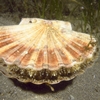General Description
Shells of this species are thin, fragile with a dark brown external coating (periostracum) which covers the shell and is fringed along the posterior margin and extends considerably beyond the shell margin. Shell up to 6 cm across.
Biology
This species is among the few bivalves to be able to move about in water. They host symbiotic bacteria in their gills which are able to utilise hydrogen sulphide from the substrate to produce amino acids and carbohydrates for food. A consequence of this alternative food source is that the gut is often smaller than other bivalves. A special secretion gives the exterior valve surfaces a water shedding (hydrofuge) surface, making burrowing in the often sticky substrates easier.
Habitat
In clear, coarse sand, from mid-intertidal areas to depth of 10 m.
Soft substrates
Coastal shores
Distribution guide
Southern Australia.
Species Group
Sea snails and shells › Bivalves
Depth
Shore (0-1 m)
Shallow (1-30 m)
Water Column
Max Size
6 cm
Diet
Organic matter
Commercial Species
No
Species Code
MoV 1704
Conservation Status
- DSE Advisory List : Not listed
- EPBC Act 1999 : Not listed
- IUCN Red List : Not listed







